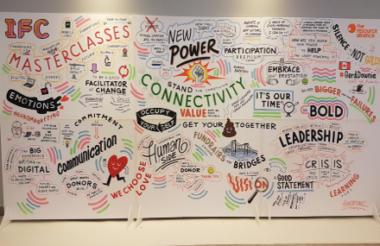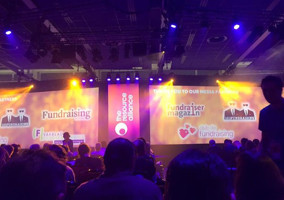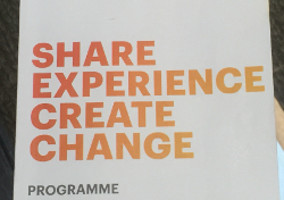Another year and another International Fundraising Congress has come and gone. Alongside the usual tropes of full-bore inspiration, both Hugh Radojev and Stephen Cotterill share some of their key learnings from this year’s IFC.
The IFC circus descended once more on the sleepy Dutch seaside town of Noordwijk this year for three (or four, depending on how keen you were) days of inspiration, innovation and one or two alcoholic beverages.
I wrote after last year’s event that ‘a cultural change seems to be afoot in fundraising’. At the time, the horrific event of the summer of 2015 had been accepted and the sector appeared to be looking to move forward together: to right the wrongs and to be better as a collective.
In terms of a more general takeaway from this year’s IFC, the 2017 congress seemed to be far more, for lack of a better expression, ‘business as usual’ than in previous years. Both the speaker programme and the delegate lists were dominated by fundraising suppliers and agencies from all over the world. Charity fundraisers themselves seemed to be relatively few and far between.
While this isn’t necessarily a bad thing, it is perhaps interesting to wonder why it was that so many senior fundraisers decided not to come to this year’s event. It is perhaps also interesting to note, having maybe steered clear of the UK market in particular of late, that large oversees fundraising suppliers now once again feel comfortable in effectively pitching for business with UK charity clients.
The darkest cloud gathering over fundraising at the moment continues to be impending GDPR legislation and quite what that will mean for the day to day work of the sector. In one or two conversations I had, it is also clear that many European countries are looking at the successes and failings of the Fundraising Regulator and, in particular, its Fundraising Preference Service, with a great deal of interest.
AI and fundraising – the future is now
Artificial intelligence is already here and is now more “affordable and scalable” than ever, according to Steve MacLaughlin the vice president of data and analytics at Blackbaud. Speaking alongside Mike Bugembe, chief analytics officer at JustGiving, MacLaughlin said that people are already using AI technology every day, even if they don’t realise it.
MacLaughlin said that Blackbaud have begun introducing AI technology to its suite of fundraising programmes, including Raiser’s Edge, to help with things like donor acquisition and, in particular retention. Using prescriptive analytics, MacLaughin said Raiser’s Edge can now remind fundraisers which donors they should be contacting and highlighting the best ways in which to approach contacting them.
Bugembe said that JustGiving also machine learning to inform its vast database of clients. He said that its technology is now so advanced that it can essentially predict how a person will react when they arrive on the JustGiving landing page: which pages they will click on, which charitable causes they are interested in and even how much they are likely to donate.
He said that his biggest fear “is that Facebook will take my machine learners because they are there, hovering around them all of the time”.
Facebook fundraising tools roll out in Europe
Early in the year, Facebook announced that it would be rolling out its suite of fundraising tools to 16 markets across the European region namely: Austria, Belgium, Denmark, Finland, France, Germany, Ireland, Italy, Luxembourg, Norway, Poland, Portugal, Spain, Sweden, The Netherlands and the UK.
The new tools include a Donate button, Facebook Fundraisers page, which can be set up by individual users, and Facebook Live, which allows users to stream live broadcasts. These features have been available in the US for some time and according to figures reported by head of strategic partnerships, social good at Facebook Anita Yuen has 750,000 registered not for profit organisations using them. Successful campaigns so far include $17m raised for Victims of Hurricane Harvey and $1.4m raised for Red Nose Day. Movember 2016 in the US reached 4.1m people through Facebook and raised $500k through the fundraiser functions alone, according to Tom D’Souza, global innovation manager at the Movember Foundation. The charity intends to integrate the new tools into this year's campaign in the UK.
Also speaking at the session, Maria Butera, head of digital at Save the Children Spain, which has trailed the tools in beta for a period of three weeks, said that the charity saw 26 per cent increase in digital giving through Facebook during the trial.
The top 15 International NGOs raised over £20bn between them in 2016
Organisations like the Red Cross, UNHCR, Save the Children and UNESCO raised some $26.4bn (r £20.4bn) between them across the globe in 2016, an increase of almost of over £500m from the previous year.
Speaking on behalf of the International Fundraising Leadership Forum, of which all three of their organisations are a part, Julie Verhaar, senior director of global fundraising and engagement at Amnesty International, Olga Prat, international fundraising coordinator at MSF and Julie Weston, director of the global fundraising hub at Save the Children International, used their Wednesday session in Holland to lay down a serious ‘stat attack’.
This £20.4bn figure was raised from more than 40 million donors around the world. With the three most generous countries in terms of income raised coming from the United States of America, the United Kingdom and Germany.
For the first time, the group’s benchmarked figures also showed that the world’s largest NGOs raised more money in Europe than they had in America, with over 50 per cent of the total income raised in 2016 being raised in Europe.
Public funding accounted for over half of this revenue (£10.1bn), with individual giving being the second largest income stream for the charities (£7.1bn). Grants from foundations represented a further £738m worth of income.
The group plans to publish its 2016 figures at some point in the near future.
My Oxfam app one year on
Nearly a year since its launch, the My Oxfam app has been downloaded 4,277 times, according to figures reported by the international charity during a session titled "Predictable surprises: My Oxfam app and technological transformation". Speaking at the session, Paul Vanags co-director of People and the Planet and former head of public fundraising at Oxfam GB, said that the app had experienced 40,620 active sessions by users including "making a donation, reading a story or buying something from the online shop", with 32 per cent of those who had downloaded the app synching it with other online accounts such as Facebook and LinkedIn.
The app was launched at the beginning of the year with only "an initial burst of publicity and a few paid-for online ads". Oxfam is looking to conduct a "managed roll-out" to its warm supporter list during the early part of 2018. Based on the data already gathered from the beta phase, Vanags predicted that the app could generate around £2m more in single gifts, and in the region of 5,000 new regular givers. "We are still very much in test mode with the app," he said. "But it is a really promising start."
Related Articles











